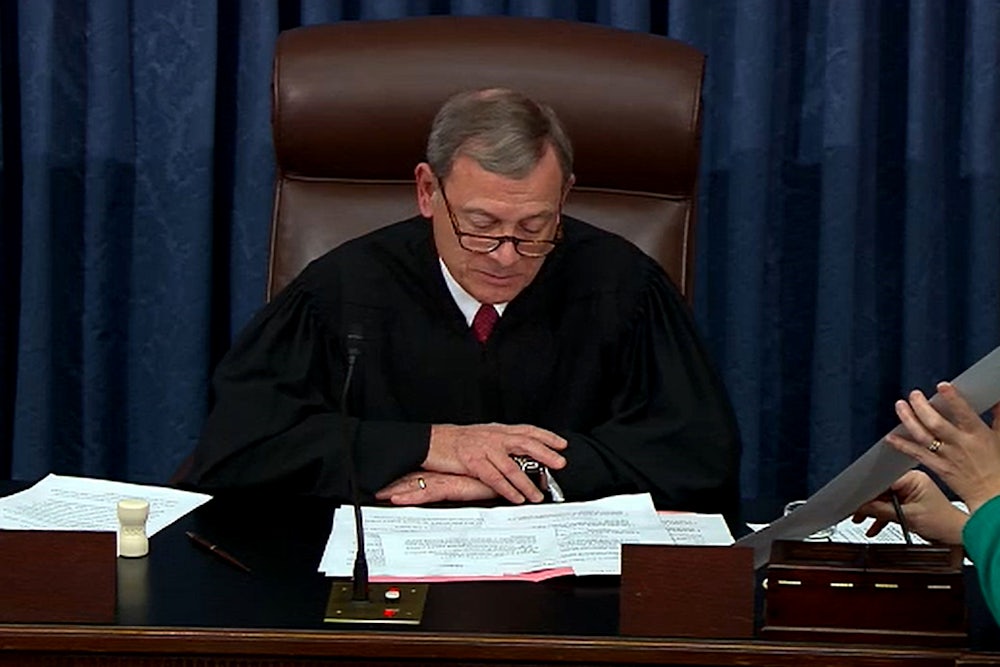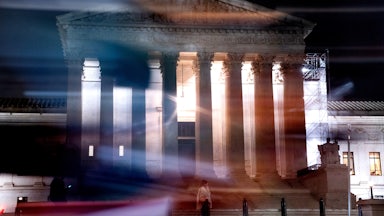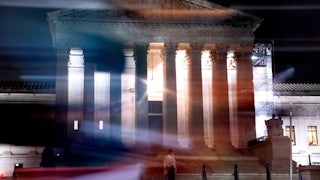In the 2013 case Shelby County v. Holder, the Supreme Court gutted the Voting Rights Act of 1965 on the premise that it violated the “equal sovereignty doctrine” by treating states with histories of entrenched racial discrimination unfairly compared to other states. Now Ohio and a coalition of 16 other states want to expand that doctrine even further to roll back environmental regulations—and potentially much more.
The case, Ohio v. Environmental Protection Agency (which is not to be confused with a recent, similiarly named case in which the Supreme Court blocked the EPA’s “Good Neighbor” rule), centers on the Clean Air Act and how the EPA regulates vehicle emissions under it. The agency is authorized to enact emissions standards, and state governments are precluded from adopting their own versions of them. The sole exception is California, which is allowed by law to adopt its own emissions standards even if they are stricter than federal standards. The California standards can, in turn, be adopted by other states as well.
This approach by Congress is somewhat unusual. The 17 states want the justices to strike it down as unconstitutional. “The Golden State is not the golden child,” Ohio and its allies claimed in their petition for review. “Yet in the Clean Air Act, Congress elevated California above all the other States by giving to the Golden State alone the power to pass certain environmental laws.” Ohio asked the justices to consider if this state of affairs violates the commerce clause and the equal sovereignty doctrine.
If Ohio persuades the justices to take up the case and ultimately prevails on the merits, it could upend how Congress enacts legislation to address specific problems or geographically discrete issues. Federal lawmakers have long tailored laws to address specific issues in certain states or treat them differently from one another. Rewriting the Clean Air Act could have far-reaching implications beyond that law.
California’s special status received renewed attention in 2019 when the Trump administration sought to lower vehicle emissions standards as part of a full-scale rollback of environmental regulations. Those efforts ran aground when four top automakers—Ford, Honda, Volkswagen, and BMW of North America—announced they had struck an agreement with the California Air Resources Board, which enforces the state emission standards, to comply with its higher standards. A few months later, Trump announced that he would revoke California’s special status, but he failed to do so before leaving office in 2021, and the Biden administration restored the status quo.
California’s efforts succeeded in part because of its disproportionate economic strength within the American internal market. If the Golden State were counted as a separate country, its gross domestic product would be the fifth-largest in the world and exceed that of major powers like France and the United Kingdom. That heft has sometimes allowed it to set de facto industry standards throughout the country, sometimes to the chagrin of corporate interests.
In 2022, for example, the Supreme Court also agreed to hear National Pork Producers Council v. Ross. The pork industry challenged a California ballot initiative that set high standards for animal confinement for meat sold within the state’s borders, arguing that it violated the commerce clause by compelling other states to follow its own regulations instead of their own. California produces almost no pork of its own, meaning that the law’s impact would be felt almost exclusively within other states, but is a major consumer of it, meaning that companies could not simply decline to sell their products there. The justices ultimately allowed the ballot initiative to survive, in a fractured 5–4 ruling.
Resentment of California’s national influence was a powerful undercurrent in that case; those resentments seem to be a driving force behind Ohio’s complaint as well. “California’s vast economy means that whatever regulations California imposes will likely set the market for the rest of the nation,” Ohio complained in its petition. The state later bemoaned that “no Ohioan (or non-Californian) voted for the policies that California voters effectively impose on Ohio and all the other states because Congress granted California a sovereign prerogative that no other state enjoys.”
In its reply brief, the Justice Department noted that California’s emissions standards scheme did not come out of thin air. (Pun not intended.) When Congress enacted the Clean Air Act, California was the only state that regulated vehicle emissions. “Congress made a waiver available to California because, at the time the CAA was enacted, that State ‘was already the ‘lead[er] in the establishment of standards for regulation of automotive pollutant emissions’ at a time when the federal government had yet to promulgate any regulations of its own,” the department noted.
California’s economic power and large population are a double-edged sword in this case. When it comes to car pollution, the Golden State faces disproportionate problems with these emissions compared to other states. “California is home to seven of the nation’s ten worst areas for ozone pollution and six of the nation’s ten worst areas for small particulate matter,” the Justice Department observed. It also pointed out that the state faces disproportionate challenges from climate change, which is caused in part by vehicle emissions. (Ohio disagreed with these claims, citing “findings” by the Trump-era Environmental Protection Agency.)
Ohio hopes that expanding the “equal sovereignty of the states” doctrine to commerce clause cases will fix this perceived problem. The challenge for them is that the doctrine does not exist—at least not as the Roberts court has described it. In two major Voting Rights Act cases, Northwest Austin v. Holder and Shelby County v. Holder, Chief Justice John Roberts framed the doctrine as an equal protection clause of sorts for the states that prohibits the federal government from treating them unfairly. It also provided the conservative justices with a fig leaf of a neutral principle to gut the landmark law.
“The Voting Rights Act sharply departs from these basic principles,” Roberts wrote in Shelby County. “It requires states to beseech the federal government for permission to implement laws that they would otherwise have the right to enact and execute on their own. And despite the tradition of equal sovereignty, the Act applies to only nine states (and additional counties). That is why, in 1966, this Court described the Act as ‘stringent’ and ‘potent.’”
This is akin to complaining that Wyoming doesn’t receive as much federal funding for hurricane relief as Florida. It is true that the Voting Rights Act imposed “stringent” and “potent” measures on those nine states, but it did so because they had violently suppressed Black voting rights since the end of Reconstruction. Congress’s cure was tailored to the disease of racial apartheid, so to speak. And it is why the Supreme Court upheld the Voting Rights Act as constitutional in 1966 despite the federalism implications.
To support the existence of the equal sovereignty doctrine, Roberts cited a mere handful of cases in the nineteenth and early twentieth centuries. In the 1845 case Pollard’s Lessee v. Hagan, the Supreme Court invalidated a provision of the law that admitted Alabama to the Union that required its “navigable waters” to remain toll-free forever. In 1911, the justices held in Coyle v. Smith that Oklahoma could relocate its state capital from Guthrie to Oklahoma City despite the language of the enabling act that admitted it to the Union. A third case in 1960, United States v. Louisiana, made a passing reference to Pollard’s Lessee while resolving a dispute between the federal government and the Gulf Coast states over their maritime boundaries after admission.
One does not have to be a Senate-confirmed federal judge to note a common theme in these cases: They dealt exclusively with the “equal sovereignty” of the states upon admission to the Union. The court’s conclusion in these cases was not that the states had to be treated equally after admission, but rather that they had to enter the Union on equal terms with the other states.
To understand why this distinction matters, it is important to understand how states join the Union. Most states first existed as territories under exclusive federal control. (There were exceptions, but those cases aren’t relevant here.) When Congress concluded that the inhabitants of a territory were ready for statehood, it would typically pass an “enabling act” to organize their political institutions and prepare for the transition. This would often involve convening a territorial legislature, organizing a state constitutional convention, disbursing some public lands, and so on.
In the nineteenth century, Congress sometimes attached conditions to statehood that it thought would bind the future states after admission. This phenomenon was more common when states had to be admitted in the antebellum era as free states and slave states. When Congress passed an enabling act in 1864 to admit Nevada the following year, for example, it required the nascent state to forbid slavery within its borders, to secure “perfect toleration of religious sentiment,” and to “forever disclaim” all unappropriated public lands within its borders.
The cases that Roberts cites make clear that their concern with “equal sovereignty” is solely reserved for the admission process. Roberts himself apparently ignored these admonitions. At one point in Shelby County, for example, he quoted the Oklahoma case from 1911 to note that the United States “was and is a union of states, equal in power, dignity and authority.” He left out the rest of what Justice Horace Lurton wrote immediately after that, which made clear its limited scope: “To maintain otherwise would be to say that the Union, through the power of Congress to admit new states, might come to be a union of states unequal in power, as including states whose powers were restricted only by the Constitution, with others whose powers had been further restricted by an act of Congress accepted as a condition of admission.”
In her dissent in Shelby County, Justice Ruth Bader Ginsburg warned against the majority’s misapplication of the equal sovereignty doctrine. “Today’s unprecedented extension of the equal sovereignty principle outside its proper domain—the admission of new states—is capable of much mischief,” she wrote. “Federal statutes that treat States disparately are hardly novelties. Do such provisions remain safe given the Court’s expansion of equal sovereignty’s sway?” She cited multiple cases in which states are treated differently from one another by federal laws, often without controversy.
Invoking the doctrine in the Voting Rights Act cases drew sharp critiques from legal scholars as well. Leah Litman, a University of Michigan law professor, wrote in a 2016 law-review article that the “principle of state equality” articulated in Shelby County had “little basis in constitutional text or drafting history, and these sources also do not specify the contours of the state equality principle.” She also noted that “the idea that federal laws cannot constitutionally specifically identify particular states or result in differential effects on different states potentially conflicts with other principles that are embodied in the Constitution’s structure, longstanding congressional practice, and judicial precedent.”
The state of Ohio did not shirk from these analyses. To the contrary, it argued that the case would allow the justices to push back against them. “Finally, this case gives the Court a chance to address the criticism that the doctrine reaffirmed in Shelby County lacks deep constitutional roots,” the state claimed, citing Litman’s paper as one example. “The petitioning states press only a single question here: do the states retain equal sovereignty with respect to each other? It therefore offers an ideal vehicle for the parties to debate the grounding and extent of that doctrine unburdened by any other questions.”
The Republican-led states have yet to convince a court to agree with them. Earlier this year, the D.C. Circuit Court of Appeals declined to adopt Ohio’s interpretation of the commerce clause. The three-judge panel concluded that the “equal-footing cases” that Ohio had cited “do not directly apply either outside of the admission context or to Article I powers like the Commerce Clause.” It also rejected the idea that the California standards exemption was akin to the Voting Rights Act because Congress had acted “squarely” within its power to regulate interstate commerce, which allows it to set any kind of vehicle emissions standards or none at all.
Whether the Supreme Court will agree with that assessment is an open question. While the justices may be reluctant to call a wide swath of other federal laws into question, the opportunity to reaffirm Shelby County’s much-criticized reasoning might be a tantalizing offer. The court’s recent track record with making up constitutional doctrine out of thin air is already poor. And the deeper cultural force at work here—a right-wing resentment of liberal California’s ability to influence the national economy—might be a potent one for the six conservative justices in the majority.










